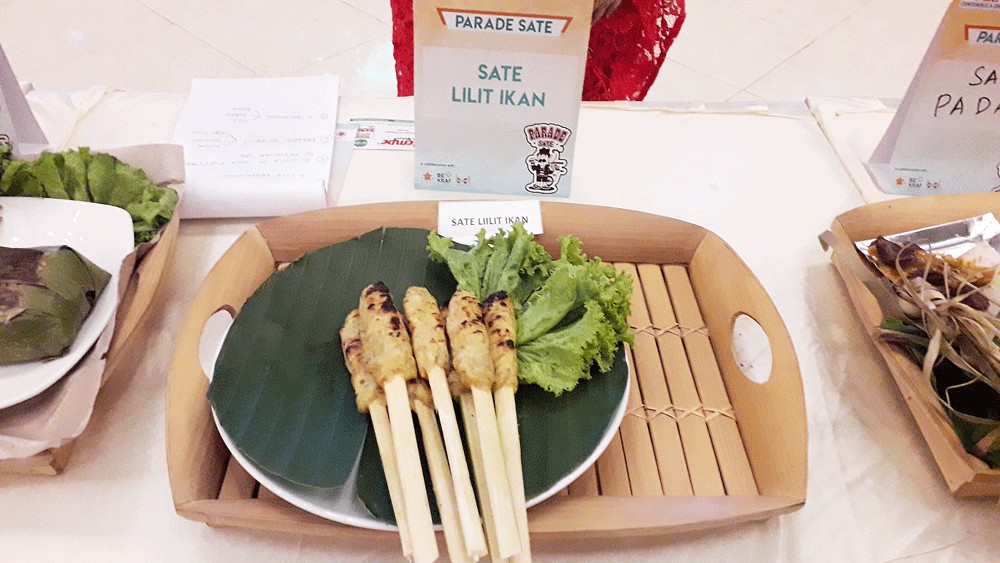Indonesia home to 252 satay varieties
Of that, the origins of 175 can be traced. The rest could not be traced and are the result of existing recipes.
Change Size
 Sate Lilit Ikan (The Jakarta Post/Sri Wahyuni)
Sate Lilit Ikan (The Jakarta Post/Sri Wahyuni)
I
ndonesia’s diverse culinary treasures go beyond the world famous rendang (a scrumptious meat dish from West Sumatra) or the beloved nasi goreng (fried rice). A new study has revealed that the country is also home to 252 satay varieties.
Murdijati Gardjito, a professor in food technology and science at Gadjah Mada University (UGM), Yogyakarta, disclosed that Indonesia had 252 satay varieties — a traditional dish consisting of small pieces of meat grilled on a skewer and served with a peanut or spicy sauce and fresh vegetables.
Of that, the origins of 175 can be traced. The rest could not be traced and are the result of existing recipes.
“Considering that it’s widespread, satay deserves to represent Indonesian culinary treasure,” Murdijati said in a discussion forum at a two-day culinary festival of fried rice and satay, which was held at the university on Tuesday and Wednesday.
Quoting research she conducted on Indonesian satay and using the Indonesian Culinary Database she worked on from 2014 to 2017, Murdijati said the 175 varieties were found in almost all corners of the archipelago except in Lampung and Mandar.
“Once the [database] program is done, I just need to input the data,” she told The Jakarta Post.
Yogyakarta is the region where the most satay varieties are found — 21. It is followed by Semarang with 12 and Bali and Pekalongan with 11 each.
In terms of ingredients, meat is still the most popular, with beef ranked first followed by chicken and lamb.
The spices mostly consist of salt and garlic followed by onion, coriander and coconut sugar.
Peanut sauce ranked first among the sauces, while the most popular complementary condiments are sweet soybean sauce, sliced onion, chili, tomato and fried onion.
Murdijati, who is also a researcher at the university’s Center for Nutrition and Food Studies (PSPG), said the research also came out with a new definition of satay as a side dish made up of meat or vegetables cooked in spices according to its respective regions.
“The unique thing is that there is a satay variant that does not meet the traditional definition of the dish. It is sate godog from Aceh, which is boiled instead of grilled,” she added.
At the festival, visitors also found other satay variants that did not meet the definition, such as sate sempol ayam, which is fried instead of grilled.
In Yogyakarta, it’s common to find sate goreng (fried satay) that is usually served without a skewer but, like grilled satay, it is also served with vegetables, such as sliced chili, onion and cabbage along with a choice of either peanut or sweet soybean sauce.
A wide variety of satay was also showcased at the festival’s bazaar for visitors to taste.
They included mushroom, squid, fish and meatball satays as well as sate bunthel (minced meat satay), sate klatak (mutton satay roasted on an open fire, which is called klatak in Javanese), sate maranggi (marinated beef satay) and sate kere (tofu satay).
The festival also put the spotlight on Indonesia’s popular nasi goreng, from seafood, lamb and Padang to fried corn rice.
Murdijati said the research she conducted on the variety of fried rice in Indonesia found that there were 104 different varieties across the country. Of them, the origins of 36 are known, while the rest was developed from existing recipes.
She added that the known origins of fried rice were all found in Java and Sumatra, which represent 50 percent of the country’s culinary regions. “Most fried rice varieties are found in Java,” said Murdijati.
The festival’s organizing committee chairperson, Retno Indrati, said the festival was jointly held by the university’s School of Agriculture Technology, the PSPG and the Community Service Directorate in cooperation with the Creative Economy Agency (Bekraf).
“The festival aims to deepen our knowledge and understanding of Indonesian food, especially satay and fried rice,” Retno added.
Other programs included a seminar on satay and fried rice, breakfast with the masters; a master class with renowned Indonesian chef William Wongso; meat-cutting and satay-grilling techniques with chef Yanto Budidarma; food-styling with Rochmat Septiawan; food photography with Agung Portal and a satay parade with chef Sisca Soewitomo.
Bekraf’s research and development director, Wawan Rusiawan, said the culinary industry had contributed immensely to the creative economy sector yet its growth was only at around 4 to 5 percent per year. “The challenge in the future is to improve that number.”
Other challenges, Wawan said, included pushing for the use of e-commerce in the sector, which so far reached only 38 percent.
However, the fact that 90 percent of Indonesia’s culinary business practitioners have not yet had legal entity status made it more challenging, considering the fact that the country’s culinary industry has absorbed 7.9 million workers.









